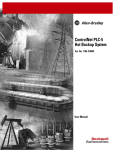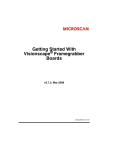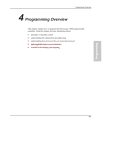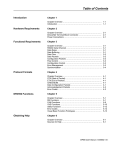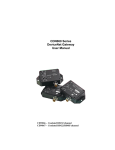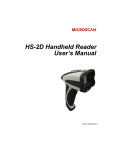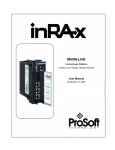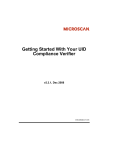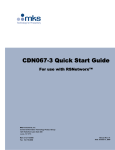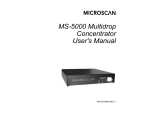Download D.I.P. CDN066 Application Note
Transcript
CONFIGURING THE DIP INC. CDN-066 FOR USE WITH AN ALLEN-BRADLEY 1747-SDN APPLICATION NOTE REVISION 01 DATE 8/01/2000 PURPOSE This note is intended to provide information on programming and setup of the DIP Inc. CDN-066 DeviceNet – ASCII Gateway module for use with an Allen-Bradley 1747-SDN DeviceNet scanner for the SLC-500 controller family. This note is not intended to replace the user manuals for either device, but instead is meant to extend the user manual content. It is assumed that the reader understands the basic operation of the CDN-066 and 1747-SDN and understands basic DeviceNet principles. INTENDED AUDIENCE New users to the CDN-066 but users with some DeviceNet experience and SLC-500 programming experience. This Application Note was tested with CDN-066 firmware 3.00. FOR MORE INFORMATION CDN-066 CDN-066 DeviceNet/Serial Gateway User Manual http://www.dipinc.com/ 1747-SDN 1747-SDN User Manual Publication 1747-6.2.5 http://www.ab.com/manuals ODVA Home Page http://www.odva.org, Open DeviceNet Vendor Home Page. ADDITIONAL MATERIALS CDN-066 EDS File Ladder Logic Prog. http://www.dipinc.com/cgi-bin/product.exe?pid=CDN066 Page 1 of 1 CDN-066 CONFIGURATION The CDN-066 is most easily configured using RSNetworx for DeviceNet configuration software. Make sure that the EDS file for the CDN-066 has been registered using the EDS wizard, then edit offline or online the configuration Parameters for the CDN-066. 1. Status: The Status information indicates whether RS232 data transfer errors have occurred. Bit 0 = Transmit channel blocked Bit 1 = Transmit buffer empty Bit 2 = Receive Parity Error Bit 3 = Receive buffer empty Bit 4 = Receive buffer Overflow Bit 5 = Framing Error Bit 6 = Transmit buffer overflow Bit 7 = State of CTS signal (1=asserted) Writing any value to the Status field through this RSNetworx window or via explicit messaging will clear the error bits. Versions 4.x and later of CDN066 firmware allow the Status byte to be optionally included in the I/O connection. 2. Baud Rate: The baud rate of the serial channel. Baud rates of 300, 600, 1200, 2400, 4800, 9600, and 19.2k baud are valid. 3. Parity: Setting the parity to 0 forces the data length size to 8. Setting the parity to non-zero forces the data length to 7. 4. Data Size: The data size is read only, and is determine by the Parity setting. The th CDN066 always reads 8 data bits, but decides what to do with the 8 bit based on the Parity setting. 5. Stop Bits: The CDN066 always uses 1 stop bit. This value is fixed. 6. Flow Control: Serial channel flow control may be set by software. See the CDN066 user manual for details on software flow control and CTS Detect usage. 7. Receive Count: Indicates the number of characters currently in the receive buffer. Writing any value to this object will flush the buffer. 8. Transmit Count: Indicates the number of characters currently in the transmit buffer. Writing any value to this object will flush the buffer. Page 2 of 2 9. Maximum Receive Size: This value indicates the maximum number of data bytes to be returned when the receive buffer is read from DeviceNet. Setting this value will automatically reset the Produced I/O Connection Size as: Input Connection Size = Max Receive Size (maximum value 64 bytes) + 1 (If String format is enabled) + 1 (If Receive Sequential Numbering is enabled) 10. Data Format: The Data Format control byte determines the type of data strings transferred via DeviceNet, which may either be an array of bytes, or an ODVA-defined Short String data element, which consists of a length byte followed by a specified number of data bytes. This control byte also determines if parity data is included in the received data, and controls padding of empty DeviceNet input data bytes if the Delimiter Character is received before the maximum data length is reached. Most ASCII text applications, such as barcode readers and weigh scales, will use Short String mode and retain parity. Default is to pad the responses with null characters and left-justify the data strings. See the CDN066 user manual for a full explanation of the Data Format byte. 11. Block Mode: The Block Mode control byte determines how the CDN066 handles delimiter characters and sequential transmit/receive handshaking numbers. Most ASCII text applications user the delimiter character but strip the delimiter from the response packet. Checking either one of the Sequence Numbers will automatically Enable the Syncronous Handshaking protocol. PLC applications always use the Re-Send Valid Data settings so that repeated polls of the CDN066 will return the same input values until a new string is received. It is important that the input data arrive at the PLC for more than one poll because the PLC scan and the DeviceNet interface scan are asynchronous. 12. Receive Delimiter: When Delimiter mode is enabled, the receipt of a specific byte will cause the Input buffer to be returned in the DeviceNet Input I/O connection. Often this byte is ASCII Carriage Return (0x0D hex, 13 decimal). If your ASCII device sends both a Carriage Return and a Line Feed at the end of ASCII strings, be sure to use the Line Feed (0x0A hex, 10 decimal) as your Delimiter character. Otherwise, the LF will show up as the first character of your next input string ! Page 3 of 3 13. Pad Character: Used by the CDN066 to fill input data packets which are less than the Max Input Size in bytes. Default is 13 decimal = 0x20 hex = SPACE. Enabling of padding and the selection of which side (left or right) to justify the input string is determined by the Data Format byte. 14. Maximum Transmit Size: This value indicates the maximum number of data bytes to be transmitted when the Output connection is received from DeviceNet. Setting this value will automatically reset the Consumed I/O Connection Size as: Output Connection Size = Max Transmit Size (maximum value 64 bytes) + 1 (If String format is enabled) + 1 (If Transmit Sequential Numbering is enabled) Note that the Delimiter Character has no effect on the transmission of serial data from the CDN066. If a Carriage Return or Line Feed or End of Text byte is needed in your application, it will need to be part of the data array which is sent via the DeviceNet output I/O connection. Page 4 of 4 1747-SDN CONNECTION AND MAPPING In our example, the Polled I/O connection between the CDN-066 and the 1747-SDN will have a Produced (Input) Data size equal to the Maximum Number of Input Characters plus two bytes, and a Consumed (Output) Data size of the Maximum Number of Output Characters plus two bytes. The default I/O connection for the CDN-066 is 18 bytes of Input Data, and 18 bytes of Output data. INPUT DATA CONNECTION CONTENTS Byte 0 Tx / Rx Handshaking Counters Byte 1 Input Length Byte Byte 2 ASCII Character 1 …. Byte 18 ASCII Character 16 OUTPUT DATA CONNECTION CONTENTS Byte 0 Tx / Rx Handshaking Counters Byte 1 Output Length Byte Byte 2 ASCII Character 1 …. Byte 18 ASCII Character 16 Because the SLC-500 uses 16-bit I/O registers, it is sometimes programmatically awkward to have the ASCII data array begin at Byte 1 (the eighth bit of the first mapped word). In RSNetworx for DeviceNet, Advanced Mapping may be used to segment the I/O mapping of the Output Data to word-align the ASCII data in SLC memory. In addition, Advanced Mapping may be employed to map the ASCII data bytes of the I/O connection to the M0 and M1 module files of the 1747-SDN. Because the 1747-SDN scanner has only 32 words of discrete I/O data, it is often scarce, and less-frequently used data is often stored in the 150-word I/O memory of the module files. M0 and M1 files require COPY instructions to be executed to exchange their contents with the SLC-500 controller memory (which requires some scan time). Because the Receive Data Request handshaking counter will be incremented in discrete memory when a new string comes in to the CDN-066, that change in value can trigger a COPY instruction that brings the ASCII data into SLC-500 memory. Example Data Map of CDN-066 in 1747-SDN memory Because the input and output data maps are the same size, this Advanced Mapping will be the same for both Input and Output. In applications with unequal Input and Output sizes, adjust the Advanced Mapping accordingly. Page 5 of 5 With the above Advanced Mapping to a 1747-SDN in Slot 1 of the SLC-500 chassis, SLC data areas where the Input and Output data will go are as follows: INPUT DATA CONNECTION MAP I:1.1 M1:1.0 M1:1.1 … M1:1.7 15 14 13 12 Receive Data Size ASCII Character 2 ASCII Character 4 … ASCII Character 16 11 10 09 08 07 06 05 04 Rx Request ASCII Character 1 ASCII Character 3 … ASCII Character 15 03 02 01 Tx Acknowledge 00 11 10 09 08 07 06 05 04 Rx Acknowledge ASCII Character 1 ASCII Character 3 … ASCII Character 15 03 02 01 Tx Request 00 OUTPUT DATA CONNECTION MAP O:1.1 M0:1.0 M0:1.1 … M0:1.7 15 14 13 12 Transmit Data Size ASCII Character 2 ASCII Character 4 … ASCII Character 16 IMPORTANT CONNECTION DETAILS 1. If the Max Input and Max Output character sizes have been changed from the default value of 16, be certain to click on the “Edit I/O Parameters” button before adding the CDN-066 to the scanlist or mapping it to the 1747-SDN memory. Correct the Input and Output connection sizes to be the [Number of Input Characters +2] and [Number of Output Characters +2] for this example, in which we are using Synchronous Handshaking mode and Short String format. 2. Once a polled connection has been mapped and downloaded to the 1747-SDN scanner module, be certain that there is not an Error Code 77 being displayed on the module’s status display for the CDN-066’s node number. This indicates a Connection Size mismatch, and the 1747-SDN is periodically sending messages to the CDN-066 to establish a properly-sized connection. This connection-request message traffic uses up the CDN066’s Explicit Message Connection, and RSNetworx for DeviceNet and RSLinx will not be able to communicate Page 6 of 6 with the module until the 1747-SDN is removed from the network or the CDN-066’s scanlist entry is deleted or deactivated. 3. If you have a properly sized I/O connection established between the 1747-SDN and the CDN-066 and attempt to change the Input or Output character sizes, you will receive an “Error 0x12: Object State Conflict” message from RSNetworx for DeviceNet. Modifying either of these parameters changes the required connection size, and therefore they cannot be changed while the connection is active. Remove the 1747-SDN from the network, or delete or deactivate the CDN-066’s scanlist entry. Turning the processor into Program Mode or the 1747-SDN into Idle mode does not break the connection and will not allow these parameters to be changed. CDN-066 OPERATION About the Transmit and Receive synchronous handshaking counters The first byte of the Input and Output I/O connections consists of two 4-bit counters which are used for handshaking. To send data out of the RS232 serial port on the CDN066, the Transmit Request value is incremented by 1. The CDN066 will send the serial data that arrived in that Output I/O poll, and respond by setting the Transmit Acknowledge counter to the same value as the Transmit Request counter. When the CDN066 received data in it’s RS232 serial port, it assembles that into an Input I/O poll response and increments the Receive Request counter by 1. When the application program detects that the Receive Request counter has incremented, it should copy the Input data into holding registers for storage, then set the Receive Acknowledge counter to the same value as the Receive Request. The next string can then be sent over the I/O connection by the CDN066. Because these counters are 4 bits apiece, their roll over at the value 15, returning to 1. The value 0 is reserved as an initial condition (for the Rx counter) and a reset value (for the Tx counter). About the Status Byte This byte indicates the status of any serial errors detected by the CDN-066. If this byte is included in the I/O connection, it makes it easy to sense overflows and reset errors on the serial side of the CDN-066. Early versions of the module (Firmware 3.x and previous) did not have the option to add this byte to the I/O connection, though it is still available via explicit messaging. Page 7 of 7 SLC-500 LADDER LOGIC EXAMPLE This Application Note should be accompanied by an example RSLogix 500 program for the SLC-5/03 programmable controller, to read and write ASCII strings from a MicroScan MS-700 barcode reader via the CDN066. Although ladder logic is flexible enough to allow many different approaches to data handling, the accompanying program will have to include at least the following elements: Enable the 1747-SDN The first word of the discrete output image of the 1747-SDN is reserved for module commands. Bit 0 of this word needs to be 1 for the 1747-SDN to send active polling commands. The 1747-SDN does poll for input data when the scanner is idle, but it’s output polls have no content and are not processed by slave devices. COPY ASCII data into memory when the Record Number changes If the ASCII data bytes of the inputand output image have been mapped to the M1 file of the 1747-SDN, a COPY instruction will be needed to retrieve them. Make sure that the SLC-500 has at least one scan to get that data into memory before acting on it. Perform handshaking logic The simplest ladder program to enable serial input for testing would be to use just an MVM instruction to maskedmove the first word of the Input map to the first word of the Output map. More sophisticated handshaking logic is usually necessary to send Output data upon a trigger, and to assure Input data is transferred efficiently out of 1747-SDN M-file memory into SLC memory. Move ASCII data into a String data type SLC-500 String data types are 42 words in length, with Word 0 designating the length in characters, and Words 1 through 41 being ASCII characters (up to 82 characters). To move an array of Integer numbers into a String data element, a COPY command can be used. Reserve Word 0 for the string length, and be sure not to use any of the Integer values above your string length but below the 41word limit for other purposes in the program. Fitting the example into your application The program accompanying this application note is written for an SLC-5/05 processor with a 1747-SDN in Slot 1 of a 4-slot chassis, with no other I/O. You will almost certainly have to perform search-and-replace functions to fit the example logic into your application program. The program is provided in RSLogix 500 version 4.10 format (*.RSS extension), as well as SLC-500 library format (*.SLC extension) for import into other versions of the software. Page 8 of 8









